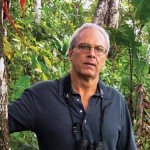Accommodation ranges from budget to boutique, food is cheap and plentiful, and locals welcome us with wide smiles and open arms.
As the sun drops on our first day, we wander down to the strip of sand below the bungalows and spy out Mount Tavurvur, the smoking gun that literally destroyed the town at its doorstep.
Unearthing Rabaul
The next morning we set out to meet the beast up close. Rabaul, a once vibrant township, is today a desolate wasteland. The blast of September, 1994 sent residents scurrying for Kokopo, more than 20 kilometres down the road. Hundreds of businesses and homes were destroyed. Very few returned. Today, there are scarce few signs of life to be seen on this grey apocalyptic landscape, covered in thick layers of volcanic ash. Fourteen years ago, the main drag of Mango Street was a cultural centre, the beating heart of the most beautiful town in the region. If we were to dig deep, we might find this former jewel of the pacific, buried under two metres of dark grey dust beneath our feet.
Even today, the smoking mouth of Mount Tavurvur looms over the former downtown area, belching puffs of heavy powder into the sky. Only in the past few months have scientists observed that the volcano is finally starting to settle, fuelling hope that regeneration might soon be possible.
Tavurvur had two accomplices when it erupted in 1994. Nearby Mount Vulcan and the smaller Mount Rabalanakaia, to the north, simultaneously spewed forth with toxic gases and raining ash. But it was Tavurvur that caused the most havoc, layering local buildings with enough ash to crush them with all the impact of several tonnes of concrete.
























